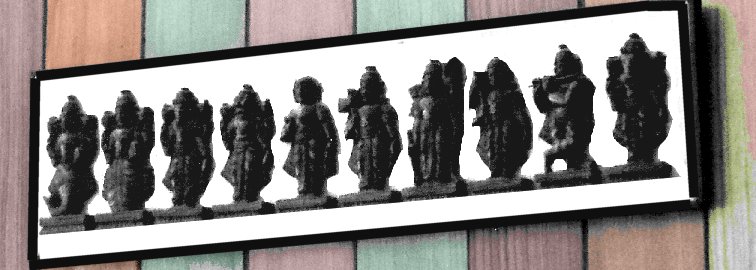



Image
used with Permission.
Throughout
the ages, Vishnu has incarnated himself in various forms when the Dharma
was in danger.
1. Matsya
- Matsya,
the 1st avatar of Vishnu, assumed the form of a fish. Matsya retrieved the Vedas
for Brahma and saved humanity from the flood.
2.
Kurma - Kurma,
the 2nd avatar of Vishnu, helped the demigods get the Nectar of Immortality
by churning the Milk Ocean. Kurma bore the mountain on his back to allow them
to churn the ocean without the mountain sinking into the ocean floor.
3.
Varaha - Vishnu
became a boar to recover the Earth from the bottom of the ocean. After
returning the Earth to safety he defeated an Asura.
4.
Narasimha - Vishnu
took the form of Narasimha, which is both man and lion, in order to kill the
evil ruler, Hiranyakashyap.
5.
Vamana - Vishnu
became the Dwarf, Vamana, to control a king who had taken over much of the earth.
6. Parasurama
- Rama the axe-wielder, or Parasurama, is the
sixth incarnation of Vishnu. He was a great warrior and the defender of
the Brahmins in their fight against the Kshatriya caste.
7.
Rama - Rama
is the seventh avatar of the god Vishnu. Rama is the hero of the Ramayana
which the story of Sita’s abduction by a demon king and her subsequent rescue
by Rama and his friends.
8.
Krishna - Krishna
is the eighth avatar of the god Vishnu. In the Bhagavad-Gita he appears
as a profound teacher. Furthermore, he is often depicted as a young cowherd
who loves the cow maidens. Other descriptions include Krishna
as a mischievous child, a heroic slayer of demons, and a king.
9. Balarama
- Balarama, the Hindu equivalent of Bacchus in
Greek and Roman mythology, is the older brother of Krishna. Those who
do not believe that Buddha is the ninth avatar place Balarama as the ninth.
9. Buddha
- Those
who do not believe that Balarama is the 9th avatar of Vishnu place the original
Buddha in this position.
10. Kalki
- Kalki is an apocalyptic figure, who will supposedly
bring an end to the Kali age in order to usher in an era of purity.

